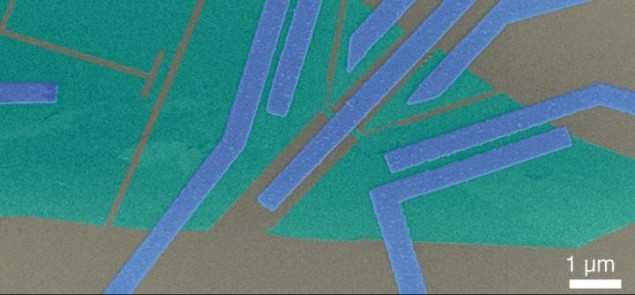
A new device that produces entangled pairs of electrons by the application of heat has been unveiled by international team of researchers led by Pertti Hakonen at Aalto University in Finland. The device works by splitting up Cooper pairs of electrons in a superconductor — and then collecting the entangled electrons. This ability to produce entangled, tuneable electrical signals could be an important step towards creating new electron-based quantum technologies and research applications.
Entanglement is a purely quantum-mechanical phenomenon that allows two or more particles, such as electrons, to have a much closer relationship than is predicted by classical physics. Once considered an exotic consequence of quantum physics, entanglement now has very practical applications in quantum computing and quantum sensing. As a result, physicists are very keen on developing new and better ways of creating entangled particles.
Temperature gradient
When a temperature gradient is applied across a conducting material, its electrons will diffuse from the hot side to the cold side, generating a voltage. Known as the Seebeck effect, this phenomenon is widely exploited in modern technologies, including thermoelectric power generators and temperature sensors.
A Cooper pair comprises two entangled electrons that are bound together within a superconductor. Because Cooper pairs are bosons, they can condense at very low temperatures and flow with zero electrical resistance. The interaction that binds the electrons is long range and therefore the electrons in Cooper pairs do not necessarily have to be very close together.
In their study, Hakonen’s team created a tiny section of aluminium superconductor that is sandwiched between two tiny graphene electrodes that functioned as quantum dots – these are semiconductors that behave like artificial atoms with electron energy levels that can be tuned separately.
Nonlocal Seebeck effect
When the researchers applied a temperature gradient across their device, Cooper pairs within the superconductor split up. Thanks to the nonlocal Seebeck effect, electrons could then leave the superconductor by tunnelling through different quantum dots – which is encouraged by setting different energy levels on the two quantum dots. These electrons can then be extracted from the device by separate metal electrodes, one connected to each quantum dot. Because the two electrons were quantum-mechanically entangled in a Cooper pair, they maintain this special relationship when separated.

Graphene quantum dots split Cooper pairs
By tuning the quantum dots, the team could vary relative contributions to the currents of electrons from Cooper pair splitting and another process called elastic co-tunnelling. This gave the team control over the two output signals of their device.
The new device could have a wealth of potential applications in electron-based quantum technologies. Furthermore, the tuneability of the device could soon facilitate fundamental tests of theoretical concepts in entanglement and thermodynamics.
The device is described in Nature Communications.



